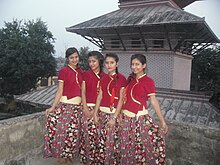This article needs additional citations for verification. (April 2024) |
| Demographics of Nepal | |
|---|---|
 Population pyramid of Nepal in 2020 | |
| Population | 29,125,600 (2021)[1] |
| Growth rate | 0.92% |
| Birth rate | 17.53 births/1,000 population |
| Death rate | 5.58 deaths/1,000 population |
| Life expectancy | 72.4 years |
| • male | 71.66 years |
| • female | 73.17 years |
| Fertility rate | 1.9 children |
| Infant mortality rate | 25.13 deaths/1,000 live births |
| Net migration rate | -4.21 migrant(s)/1,000 population |
| Age structure | |
| 0–14 years | 28.41% |
| 15–64 years | 65.69% |
| 65 and over | 5.90% |
| Sex ratio | |
| Total | 0.96 male(s)/female (2022 est.) |
| At birth | 1.06 male(s)/female |
| Nationality | |
| Nationality | Nepali |
| Language | |
| Official | Nepali |






The current population of Nepal is 29,164,578 as per the 2021 census. The population growth rate is 0.92% per year.[2][3]
In the 2011 census, Nepal's population was approximately 26 million people with a population growth rate of 1.35% and a median age of 21.6 years.[4]
In 2016, the female median age was approximately 25 years old and the male median age was approximately 22 years old.[5] Only 4.4% of the population is estimated to be more than 65 years old, comprising 681,252 females and 597,628 males. 61% of the population is between 15 and 64 years old, and 34.6% is younger than 14 years.
In 2011, the birth rate is estimated to be 22.17 births per 1,000 people with an infant mortality rate of 46 deaths per 1,000 live births. Compared to the infant mortality rate in 2006 of 48 deaths per 1000 live births, the 2011 IMR is a slight decrease within that 5-year period. Infant mortality rate in Nepal is higher in rural regions at 44 deaths per 1000 live births, whereas in urban regions the IMR is lower at 40 deaths per 1000 live births. This difference is due to a lack of delivery assistance services in rural communities compared to their urban counterparts who have better access to hospitals and neonatal clinics.[6]
Life expectancy at birth is estimated to be 67.44 years for females and 64.94 years for males. The mortality rate is estimated to be 681 deaths per 100,000 people.
Net migration rate is estimated to be 61 migrants per 100,000 people.
According to the 2011 census, 65.9% of the total population is literate.[7]
- ^ "Nepal's population is now 29,164,578". Archived from the original on 24 March 2023. Retrieved 24 March 2023.
- ^ Republica. "Nepal's population is now 29,164,578". My Republica. Archived from the original on 24 March 2023. Retrieved 24 March 2023.
- ^ "Nepal makes public final data of 12th national census". kathmandupost.com. Archived from the original on 24 March 2023. Retrieved 24 March 2023.
- ^ "National Population and Housing Census 2011 (National Report)" (PDF). Central Bureau of Statistics (Nepal). Archived from the original (PDF) on 18 April 2013. Retrieved 26 November 2012.
- ^ "The World Factbook — Central Intelligence Agency". www.cia.gov. Archived from the original on 13 June 2007. Retrieved 4 April 2017.
- ^ Lamichhane, Reeta; Zhao, Yun; Paudel, Susan; Adewuyi, Emmanuel O. (1 January 2017). "Factors associated with infant mortality in Nepal: a comparative analysis of Nepal demographic and health surveys (NDHS) 2006 and 2011". BMC Public Health. 17 (1): 53. doi:10.1186/s12889-016-3922-z. ISSN 1471-2458. PMC 5223552. PMID 28068969.
- ^ "Nepalese peoples and nationality law". The World Factbook. CIA. Archived from the original on 9 January 2021. Retrieved 3 September 2016.